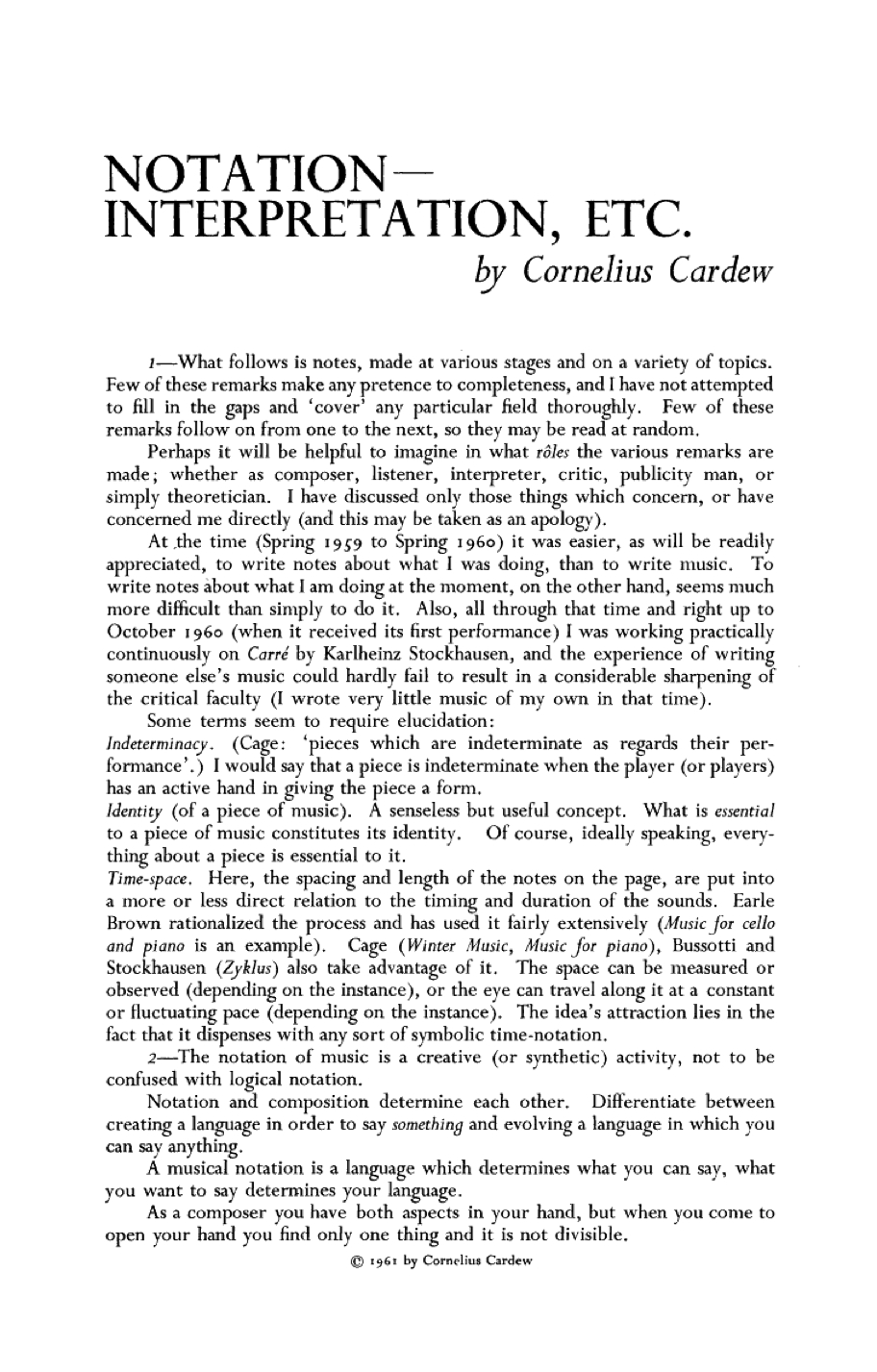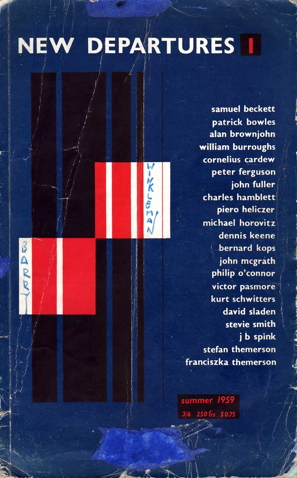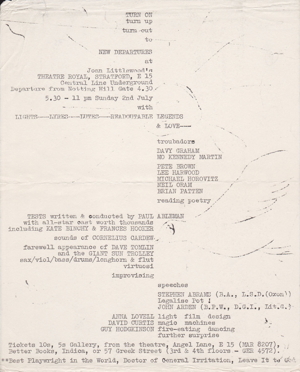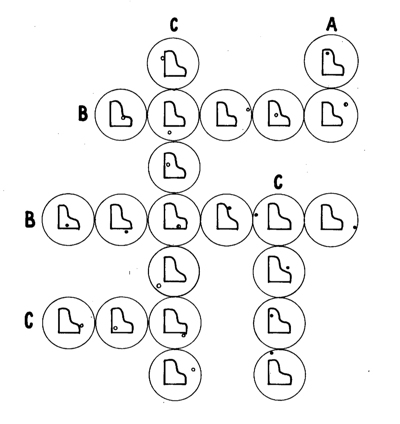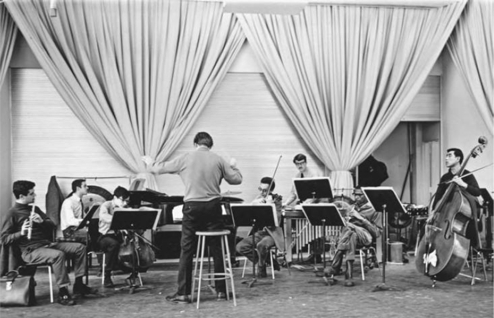> Studies > FAC-SIMILES
CORNELIUS CARDEW (AND FRIENDS)— AMM — The Scratch Orchestra —— Red Flame Proletarian Propaganda Team — People’s Liberation Music —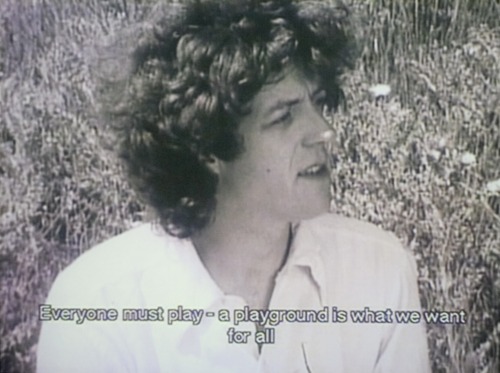
page 2 — 1961-1966page 1 (1958-1961) — page 3 (1966 - AMM) — page 4 (1968-1969) — page 5 (1969-1972) — page 6 (1972-1981)page 7 (list of works, references & concerts timeline) |
1961-1966(Edit)
Cardew, notation - interpretation, etc. (1961)(Edit)
In Tempo, New Series, No. 58 (Summer, 1961), Cambridge University Press, pp. 21-33.
Treatise (1963-1967)(Edit)
AUDIO
BBC
Source : Ubu.com
|
Cardew returned to London in 1961 after his stay in Cologne and decided to propagate and promote the music of the American composers. He became involved, as the music editor, with New Departures, an arts magazine (1959-1984) established at Oxford by his schoolfriend David Sladen, Pete Brown, and the poet Michael Horowitz, and that looked beyond the narrow British scene [around Samuel Beckett] and turned to America and the Beats for inspiration [around William Burroughs]. New Departures also has strong ties to jazz. For instance, the fourth issue of New Departures deals with jazz and poetry and around this time Horovitz and Brown took their show on the road with their Live New Departures venues. These venues were important in extending the reach of the avant outward beyond London and in turn bringing new talent from the outskirts into the cultural vortex of the metropolis. At its best, New Departures had fulfilled its editor’s original intention of making it a forum for all the arts : poetry by leading authors from various parts of the world has been accompanied by graphic and photographic work, and musical scores by eminent experimental music composers have also been published. David Hockney is notable among the artists who have supplied illustrations ; composers whose work has been featured include John Cage and Cornelius Cardew. The energies fo Horovitz and his associates were diversified in the magazine’s early stages into the ‘Live New Departures Roadshows’, the principal platform for the performance of poetry in combination with music and drama through the 1960s and 1970s. « As soon as New Departures #1 appeared in summer 1959, my co-editors John McGrath (drama), Cornelius Cardew (music), Anna Lovell (art), David Sladen (general co-editor) and I realised that we were as concerned with live communications as with print. So we went on the road with the first Live New Departures bandwagons, bringing each of the genres to physical life including interplay with one another, often in venues not hitherto devoted to arts activities, and seeking audiences from any and every background. » — (Michael Horowitz, interview 2015, online revue Write Out Loud) In 'The Unity of Musical Space' (published in New Departures, nr. 1, Summer 1959), written at the age of 23, Cornelius Cardew writes: « the difference between a world and a tone-row is only quantitative: a stable world with an inverted tone-row in it, and a stable tone-row with an inverted world round it are equivalent phenomena. » Soon such fluent Darmstadt-inspired formulations are abandoned as he discovers the thought — and, crucially, the writings — of Cage and Feldman, and quickly proves their equal in speculative brilliance and insight. The article 'Notation-interpretation, etc.', published in Tempo in 1961 (No. 58 Summer 1961), is especially rich, particularly as Cardew's dual expertise as composer and performer (his instrument was the piano) allows him to ask questions and investigate theoretical dilemmas and subtleties few others could have done. — (James Weeks, in Tempo, July 2007) As early as June 1962, a Times critic at a Wigmore Hall concert where music by Cage, Feldman and Christian Wolff was played noted with pleasure that Cardew ‘actually played the piano instead of trying to demolish it’. In the programme notes of this concert, Cardew wrote, « For performances of such pieces a high degree of awareness is required... The ability to react spontaneously within situations that are familiar and yet always fresh in detail is a skill that has to be acquired. » It took time, though, for the new experimental music to be widely accepted in London, and Cardew became known not just as an outstanding and original composer, and a charismatic performer of difficult music, but also as a fluent writer and critic, able to discuss the crossover from art to music. Later in 1964, he studied with Goffredo Petrassi in Rome, supported by a scholarship from the Italian government. In the mid-1960s Cardew became affiliated to the Center for Creative and Performing Arts at State University of New York, Buffalo. He had acquired a passion for notation and design while working as Stockhausen’s amanuensis, and in 1961 took a typography course and graphic design at the London School of Printing, a field in which he worked intermittently for the rest of his life. Cardew’s interest in typography was soon transferred to musical notation and to the almost insurmountable task faced by a composer of contemporary music who sought to give performers some freedom of action. Fascinated with music as sound, with the human response to different sounds, and with the difficulty of exactly notating their production, he explained to Horowitz, circa 1960, when taxed with his lack of interest in politics, that he was really interested only in ‘noise’. « While there I came to be occupied more and more with designing diagrams and charts and in the course of this work I became aware of the potential eloquence of simple black lines in a diagram. Thin, thick, curving, broken, and the varying tines of grey made up of equally spaced parallel lines, and then the type - numbers, words, short sentences like ornate, literary, art-nouveauish, visual interlopers in the purely graphic context of the diagram. » — (Cardew, cited by Tilbury) « IN THE NOTATION OF MUSIC YOU ARE DEALING PRIMARILY WITH PEOPLE » he wrote in 1962. Evident is his insistence on an ethical dimension of music-making. the demands (and not simply musical ones) made by indeterminacy on both composer and performer. Frequently this leads to an apprehension of failure. In a lecture on Autumn '60 he laments the insecurity and 'melancholic' air of a performance of the work, attributable, he feels, to the 'transitional' character of the present time with regard to indeterminate music, and his inability to help the musician transcend it. His restlessness drives him to find more successful notations, and finally to abandon conventional notation altogether in the great graphic score, Treatise. — (James Weeks) « My age of romanticism is over. Sensations, moments, drop away. My desire is to experience long-term continuities as beautiful. In the Treatise to create the coherent code which expresses the truths we do not know and cannot live up to. » — (Cardew, Journal, September 1963) Beginning in 1963 Cardew began to compose graphic scores, which used visual representations in place of traditional notation. Between 1963 and 1968, he composed this monumental graphic score Treatise, a 193-page document inspired by the German philosopher Ludwig Wittgenstein's Tractatus. The central concern of Tractacus is (rather crudely) the nature of language and communication, and its function in how we might make sense of the world. The backbone of Treatise is perhaps its exploration of the nature of language and communication within the music context - that is, notation, the tool most commonly used within the Western art music to ‘discuss’ or share music. He came to believe, John Tilbury says (in his book 'Cardew: A Life Unfinished'), that it was only ‘through the spontaneous generation of sounds in freely improvised music’ that music could aspire to a sourceless and transient autonomy, the ambition of his friend Morton Feldman. As a result, the manuscript of his first major work, Treatise, looks more like an artwork than sheet music – a ‘graphic score’ – with wavy lines and exuberant diagrams providing only the most approximate guide to what needs to be played. Often Cardew offered little or no explanation of these graphic elements, leaving interpretation of the pieces to the broad discretion of the performers. Cardew later described it as ‘an attempt to escape from the performance rigidities of serial music and to encourage improvisation amongst avant-garde musicians’. Some excerpts of the Treatise Handbook: 6th Feb 63 A composer who hears sounds will try to find a notation for sounds. One who has ideas will find one that expresses his ideas, leaving their interpretation free, in confidence that his ideas have been accurately and concisely notated. 8th Feb 63 Notation is a way of making people move. If you lack others, like aggression or persuasion. The notation should do it. This is the most rewarding aspect of work on a notation. Trouble is: Just as you find your sounds are too alien, intended 'for a different culture', you make the same discovery about your beautiful notation: no one is willing to understand it. No one moves. Such views are indicative of the direction Cardew's thoughts had taken through the early 1960s, shifting by degrees from the idea of notation as embodying or representing a specific sound, to the idea of notation as a stimulus for interpretation; that is, any notation must take into account the likely or possible interpretation of the performers themselves rather than be imposed from without. A notation must 'mesh with life'. — (James Weeks) Cornelius Cardew’s 193-page graphic score Treatise (1963-1967) can rightly be considered a landmark work. No one before (and, most likely, no one since) has attempted to write such a monumental score in a notation other than that of common-practice music. Treatise, as a graphic work, is inderterminate as to performance, although Cardew designed it as a consistent system of symbolic elements. He then made its indeterminacy greater by not providing a legend of these elements to facilitate interpretation : if he had done so, the piece could have been read as an alternative symbolic notation, much like Earle Brown’s Four Systems. Instead, Cardew provided no instructions at all, releasing Treatise form a specific symbolic interpretation, from notation as printed instruction, even from fixed musical or pictorial meaning. However, pictorial elements can be interpreted or read as suggestions : factory or power station, a car, stylised forms or vague allusions, like the interpretation of figures in clouds, in the wake of Satie’s instructions on much his piano music. Keith Rowe (see AMM) made a notable participation in the Stratford performance of Treatise in September 1965. It was not until 15 January 1966, a recording broadcast by the BBC in the series ‘Composer’s Portrait’, that Rowe had a profound effect upon Treatise and upon Cardew’s concerns with experimental music. John White (trombone), John Tilbury (piano), David Bedford (accordion), Keith Rowe (electric guitar), Peter Greeham (Hammond organ), and Cardew (piano, gongs, and radios) played on the BBC recording. During his residency in Buffalo in 1967, Cardew wrote a portion of his large work Treatise, which he called Treatise, Fragment: American Pages (1966), published by Ed Budowski’s The Gallery Upstairs Press in Buffalo, a graphic score into which he had channelled most of his creative energy since 1963. « In my piece there is no intention separate from the notation; the intention is that the player should respond to the notation. He should not interpret in a particular way (e.g. how he imagines the composer intended) but should be engaged in the act of interpretation. » (Cornelius Cardew). « Each [musician] is free to interpret [Treatise] in his own way. » (Cornelius Cardew, Treatise Handbook, p. IX) « Bear in mind that parts of the score may be devoid of direct musical relevance. [...] In the case of Treatise a line or dot is certainly an immediate orientation as much as the thread in the fog. [...] Remember that space does not correspond literally to time. » (Cornelius Cardew, Treatise Handbook, p. IV) « The notation is more important than the sound. Not the exactitude and success with which a notation notates a sound; but the musicalness of the notation in its notating. [...] There is a great difference between: a) doing anything you like and at the same time reading the notations, and b) reading the notations and trying to translate them into action. Of course you can let the score work on previously given material, but you must have it work actively. [...] Reflection before a performance. A musical score is a logical construct inserted into the mess of potential sounds that permeate this planet and its atmosphere. [...] Performance advice. Divide the musicians into those involved in dot events (percussionists and pianists?) and those involved in line events. Dot events to be exclusively soft. » (Cornelius Cardew, Treatise Handbook, p. VII) « It should be pointed out that none of Cardew's works ever gave total freedom to the performer. The instructions were a guide which focused each individual's creative instinct on a problem to be solved - how to interpret a particular system of notation using one's own musical background and attitudes. » (John Tilbury) However, Cardew concentrated on the independence of the interpreter from the moment he became dissatisfied with Stockhausen’s control of what Cardew called a ‘Basic Score’ from which he had to realise the former’s Carré for four orchestras. Cardew wrote sarcastically about his experiences of playing Plus-Minus. He particularly noted Stockhausen’s indication ‘for composers’ which stood in place of ordinary instrumental indications. « I have now been involved in 5 ‘compositions’ (performances) of the piece, so I am in a position to give a ‘survivor’s account’ of what actually is implied by the enigmatic superscription : ‘for composers’. » (Cornelius Cardew) For Stockhausen, the performance is made in his service ; the piece remains his and the performers should divine his intention even when it is not written down. For Cardew, the resulting performance is a collaboration of the performers and his score. « What emerges from all this is that in the work of many composers (including Feldman, Wolff, Cage, myself, Rzewski, La Monte Young, and even Stockhausen if he himself happens to be absent) the interpretation of the ‘instructions’ for a piece has a decisive influence on the performance. » (Cornelius Cardew, ‘On the Role of the Instruction in the Interpretation of Indeterminate Music’ in Treatise Handbook, London : Hinrichsen, 1971, p. XV) — (Virginia Anderson, 'Aspects of British Experimental Music as a Separate Art-Music Culture', PhD thesis, Royal Holloway, University of London, 2004) The performance he, Jan Williams, and Edward Burnham gave in April 1967 at the Albright-Knox Art Gallery was the first U.S. performance of Stockhausen’s work Plus Minus (for composers) (1962). Cardew supplied the following note for the program : « I began composing this piece several years ago and have now reached the third page. Things are slowing down; at this point it takes me 26 minutes to play only four events. So I decided to hand on the esoteric information obtained by me in the course of my work to my two percussionist friends, Jan Williams and Ed Burnham (both of whom come relatively fresh to the art of composition), in the hope that they might wring some less somber constellations from the complex mass of data and directives originally provided by Mr. Stockhausen. This evening’s performance consists of simultaneous presentation of their work and mine. » 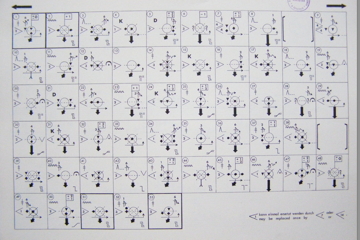 Karlheinz Stockhausen, Plus Minus, score extract. — [large view] — [pdf score download] One might ask, « To what degree is the performer also the composer ? », Cardew posed a related question as it pertained to the London-based performance group, AMM : « Does the collaboration of a set of minds mean the development of another authority independent of all members but consisting of them all ? » « The danger in this kind of work is that many readers of the [Treatise] score will simply relate the musical memories they have already acquired to the notation in front of them, and the result will be merely a gulash made up of the various musical backgrounds of the people involved. For such players there will be no intelligible incentive to ‘invent’ music or extent themselves beyond the limitations of their education and experience. » (Cornelius Cardew, ‘Towards an Ethic of Improvisation’, Treatise Handbook, p. XIX). For Cardew, the answer to these limitations was Keith Rowe, with his musical illiteracy and visual acumen; for those of us who are musically literate the answer may lie in considering that a strictly symbolic musical interpretation may not be the only, or even the best way in which to approach Treatise. — (Virginia Anderson, 'Aspects of British Experimental Music as a Separate Art-Music Culture', PhD thesis, Royal Holloway, University of London, 2004) « I now regard Treatise as a transition between my earlier preoccupation with problems of notation and my present concerns - improvisation and musical ife. Joining AMM was the turning point, both in the composition of Treatise and in everything I had thought about music up to then. » — (Cardew 1970, cited by Tilbury) In "Wiggly Lines And Wobbly Music", an article for the journal Studio International (1976), he described this elegant composition as a cross between a novel, a drawing and a piece of music. — (cited by Julian Cowley) In Treatise Cardew takes notation's interpretative potential to the limit, avoiding anything that may be literally 'translated' into sound; by the end of the Treatise Handbook he has gone further, doing away with any compositorial mediation whatsoever and espousing free improvisation, proclaiming that the « writing down of music is in the process of disintegrating. » Ever one to see clearly the extreme points of a situation, he recognized the need to go beyond even what little determination Treatise offers and liberate the performer completely from the constraints of notation. « We are searching for sounds ... rather than thinking them up, » he wrote of his collaboration with AMM. « The search is conducted in the medium of sound and the musician himself is at the heart of the experiment. » He investigated the potential of ordinary words as notation, using the common medium of human communication to create musical scores. Cardew stressed the need for maximum clarity in the wording, allowing performers to be creative interpreters while precluding recklessness. Increasingly, Cardew questioned the authority assumed by conventional musical education, and sought to dispel any sense that musicians were special people, set apart from humdrum reality. Virtuosity deserved respect, but not to the exclusion of other qualities and abilities. Still, Cardew accepted that Treatise appeared daunting even to highly trained musicians. He became interested in devising music which enabled as many people as possible to participate. Later, Michael Chant suggests that one of Cardew's finest qualities was that he consistently posed the question of how there could be mass participation, direct participation, in music making. His experience and his character led him to the pursuit of the collective expression of what is emancipating and what will emancipate the human personality. Later Cardew came to view communism as the route to this progressive goal.— (cited by Julian Cowley) His beautiful essay Towards an Ethic of Improvisation finally abandons notation theory altogether for 'Virtues that a Musician can Develop': Simplicity, Integrity, Selflessness, Preparedness/ Awakeness, Identification with nature and Acceptance of Death. — (James Weeks) 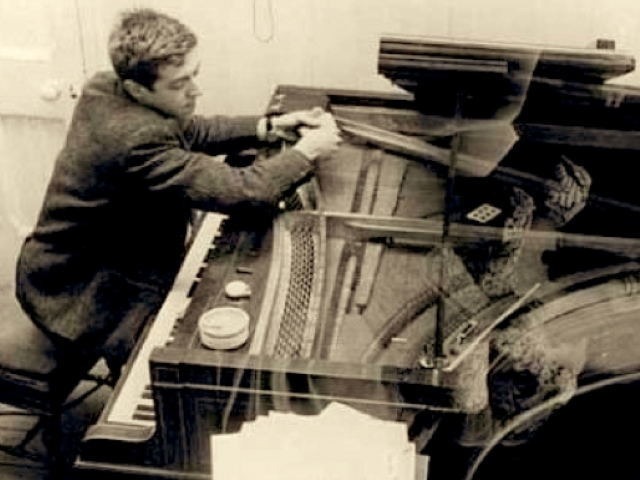 Cornelius Cardew, circa mid-60. 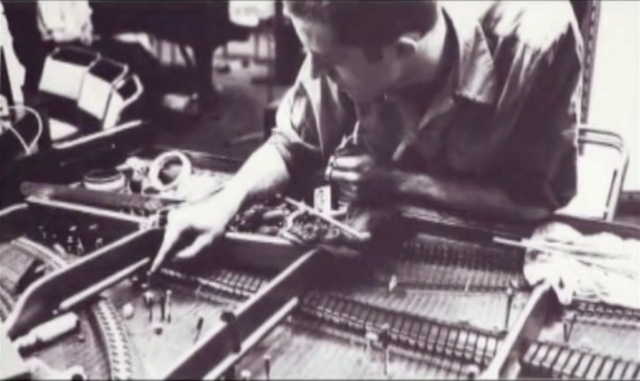 Cornelius Cardew, preparing a piano. |
AUDIO
Cornelius Cardew — Memories of You (1964) —
David Ryan, piano Recorded at Gateway Studio, Kingston-upon-Thames on 6 and 7 April 2001. Matchless Recordings - Cornelius Cardew - Chamber Music 1954-1964 Source : Matchless Recordings
DATES :
— 1961, Paris — Cardew performed 1698 for Henry Flynt, in July 1961 (?) — [more info] — (Quotation by Branden W. Joseph, "Andy Warhol's Sleep : The Play of Repetition", In "Masterpieces of Modernist Cinema", Edited by Ted Perry, Bloomington IN : Indiana University Press, 2006)
— 1961, London —La Monte Young’s 42 for Henry Flynt performed with Cornelius Cardew. — [more info] — Cornelius Cardew performed Lamonte Young’s "42 for Henry Flynt" and Susan Bradshaw interrupted the performance by dragging him away from the piano. — (unknown reference)
— 1963 — Cornelius Cardew, Ah Thel, chorus w/opt. piano (1963) (text by William Blake) - published in The Musical Times, Vol. 104, No. 1449 (Nov., 1963), pp. 1- 4
— 1964, Roma, Italy — Stockhausen, Plus/Minus, first performance, Rome 14 June 1964 - performers : Cornelius Cardew, Frederic Rzewski. Cardew and Frederic Rzewski premiered Plus-Minus in Rome on pianos ; Rzewski played electric organ as well, Cardew played tree transistor radios.
— 1964-65, Roma, Italy — Cardew, Bun No. 1. Bun No 1 (in French, "chignon"), a revision of his ''Third Orchestral Piece'' (1960), dates from 1965, a period when Cardew was still in thrall to European modernism. It is a relatively early piece, written before the time of Cardew’s intense political activism, when he was studying in Italy with Goffredo Petrassi. He undertook this study in order to 'learn a feel for the orchestra.’ The piece is confidently in the postwar European serial style; its orchestration is masterly and its continuity is clear and compelling. "Cardew deploys a whole panoply of techniques – contrary motion, retrogrades, glissandi, harmonics, staggered entries, extreme contrasts of loud and soft, angular motifs, cautious stepwise movement, decisive synchronised attacks, extremes of range from the deepest tuba to the highest piccolo, transparent chamber-music-like part-writing, massive tutti exclamations, and almost constantly changing time signatures." — (Calum McDonald, programme notes).{br} According to Cardew’s biographer John Tilbury, “The piece was written in Rome when Cardew was studying orchestration, and there’s never a dull moment. It’s like a series of very strong, vivid images, not connected to each other, and it has a strong granitic quality, with piercing woodwind lines somewhat like Varese. [...] Why 'Bun'? He gave me two off-the-cuff reasons when I asked him: a bun is what you give to an elephant at the zoo, and that was how he felt when he gave the work to an orchestra to play; and the piece is like a bun - filling but not substantial!”
— 1964, London — Concert ICA Gallery, December 1, 1964 - Some Items of Experimental Music - by Robin Page, Cornelius Cardew - Works of Guiseppe Chiari, Frederic Rzewski, Morton Fledman, John Cage, LaMonte Young, Cornelius Cardew, Robin Page.
— 1966, London— A new Moon of Carnival of Poetry in the Round, The Royal Albert Hall, 18th of June, 1966. Considered the birth of English underground, this exhibition involved the most active, alternative poets of that period – Pete Brown, Michael Horowitz, Bob Cobbing among the others and musicians as like Cornelius Cardew and John Renbourn —, one year after the very first poetry meeting year before, in August 1965 (at the Royal Albert Hall), with Ginsberg, Corso, Horowitz, Mitchell, Fainlight and others.
— 1966, Buffalo (USA)— Cornelius Cardew was invited at the Rockefeller Foundation Center For New Music in Buffalo. He was scheduled to perform the premiere of a recently discovered piano piece by Anton Webern and to participate on a panel of composers on the subject of Webern’s legacy at Webern Society meeting in Buffalo in late October 1966. While at the Center, Cardew performed in works by his colleagues Niccolo Castiglioni, Carlos Alsina, and music department faculty member Leo Smit, as well as Stefan Wolpe, Roberto Gerhard, and Karlheinz Stockhausen.
— 1966, — David Bedford and Cornelius Cardew, Conversation, In The Musical Times, Vol. 107, No1477 (March 1966), pp. 198-200+202.
— 1966, — Cornelius Cardew, One Sound: La Monte Young, In The Musical Times, Vol. 107, No. 1485 (November 1966), pp. 959-960.
|
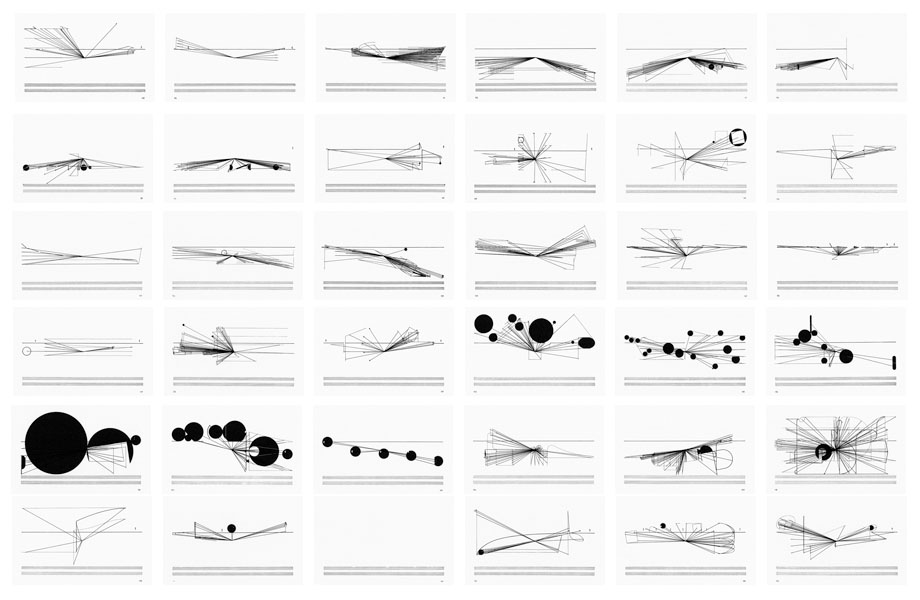 Cornelius Cardew, Treatise, scores extract — [pdf score download] — [pdf treatise - handbook download] |
Presentation of Treatise (Tony Harris)(Edit)
A presentation of Treatise by Tony Harris (in "The Legacy of Cornelius Cardew", Ashgate, 2013) Treatise unfolds over a 193-page sequence of graphics. It takes the form of a continuous weaving of shapes and symbols, only in handful of which are recognisably related to conventional music notation. A double stave runs across the bottom of each page providing the only initial evidence that the score’s intention is perhaps a musical one. The graphics themselves include lines and dotes of varying boldness, numbers, filled and unfilled squares, circles, triangles and fragments or derivations of such shapes alongside irregular shapes. Musical symbols include staves, clefs, sharps, flats, rests and note stems sometimes appearing as one would expect, but more often skewed in some way or combined with other graphics. In addition to the graphics a single black line is evident throughout. This line is sometimes disrupted or hidden, but, with the exception of just five pages, implicit on every page. Some pages are sparse with perhaps just a single graphic event but most certain multiple symbol types and juxtapositions of varying complexity. But the score is not hapharzard or nonsensical. Rather than an abstract sequence of disconnected imagery, the pages demonstrate a mostly logical flow from start to finish. Ideas are expanded and explored; ideas draw to a close; new ideas are introduced. A scan through from start to finish shows thematic development and the recapitulation of earlier gestures. Treatise is, in essence, a visual composition. « I wrote Treatise with the definite intention that it should stand entirely on its own, without any form of introduction or instruction to mislead prospective performers into the slavish practice of 'doing what they are told » — (Cardew, 1971) The Treatise Handbook (1971) takes the form of a collection of the notes Cardew made during the creation of the score alongside largely anecdotal information relating to specific performances of Treatise rather that a guide to its realisation. While performers might choose to consciously inform their interpretations of Treatise with reference to the precedents outlined in the handbook, the original intentions of avoiding ‘slavish practice’ are kept largely intact. The Treatise score could act, and has acted, as a stimulus for improvised music; a stimulus for a performance achieved through protracted and democratic discussion among the performers; a starting point for a more formally prepared compositional activity; an electronic or electroacoustic work; a multi-media or inter-disciplinary performance; of any number of unimagined responses to the question of how to represent the score in alternative and perhaps not necessarily sonic ways. Additionally, and significantly, a performance does not necessarily require the services of what we would traditionally regard as trained musicians. Cardew himself, through his work with AMM and through other compositional endeavours, demonstrated the multiplicity of the score. Both the orchestral Bun No.2 (1964) and Volo Solo (1965) for any solo instrument are composed realisations of Treatise; the former is based on pages 45-51, the latter ‘contains (with a few trivial alterations connected with the gaps, which figure in Treatise as numbers) the entire formal scheme of Treatise transliterated into well-tempered pitches’ (Cardew,1971). Cardew also engaged in performances of Treatise, including with AMM, and including versions based on varying amounts of predetermined decision-making and more spontaneous improvisatory approaches. Tilbury notes that Cardew’s attitude towards Treatise became freer as a result of his work with AMM. Question : How did Cardew’s involvement with AMM influence his work on Treatise ? John Tilbury : "His attitude towards it changed. It became freer. It was something you could use more impressionistically whereas originally I think it was more like a real notation - what does this and that symbol mean; how does the modification of that symbol affect the sound and all those sorts of things. A lot of people to this day do it like that. There’s no reason why they shouldn’t. But then having done it with AMM - with three of them coming from art background they have a freer response to it. They work backwards - Keith Rowe would see something in a far corner I hadn’t even noticed. I would be working left to right like a typical musician. He looked at it more like a picture." What Cardew had discovered through working with AMM and Treatise was less to do with specific compositional technique and more to do with identifying a mode of music making that blurred the lines between the acts of composition, the acts of interpretation, and the acts of performance - a mode that essentially integrated these elements of the creative process, and a mode that beginning to characterise his work. For Cardew, the real value of indeterminate systems was to encourage human influence on the music : ‘how to interpret a particular system of notation using one’s own musical background and attitudes’ (Bedford, 1982) — (for Cage, it was with the relinquishing the human influence, to allow the sounds to act for themselves or to limit the musical and cultural baggage which a musician might approach the realisation of a score). « [The] work of Cardew has grown from a need to simplify demands and presentation without compromising ideals in an increasingly accessible way. By contrast, Cage’s and Wolff’s indeterminate scores of the early sixties not only demand considerable technical expertise in performance, but also the ability to comprehend quite sophisticated abstract musical concept. » — (Michael Nyman) Similar distinctions are apparent in the values Cage and Cardew attach to aspects of collaboration, a theme that preoccupied Cardew since the Stockhausen experience. For Cage, collaboration was a further means of liberating the music from the stranglehold of flawed human intervention - the theory being that the more personnel involved, the less opportunity for a single ‘personality’ to inflect the music. While Cage was excited by the social implications of collaborative music making, Cardew saw the social interactions as the very ‘personality’ of the music. The final performance can ‘only’ be characterised by the approaches and musical baggage or personalities of those interpreting them. Cardew’s focus, then, was on the social, the self, the person, their social interactions, their intellectual stimulation, their ‘musical well-being’ perhaps. — (Tony Harris) |
 | Treatise Fragments, American Pages, December 17, 1966, Creative Associates at the University of Buffalo, Albright-Knox Art Gallery, Buffalo (N.Y USA). — Source : Buffalo New York Courier Express New Music — Creative Associates at the University of Buffalo will present and « Evening for New Music » at 8:30 Saturday night in the auditorium of Albright-Knox Art Gallery. Two new compositions on the program were written by Creative Associates. They are « Canzoni » by Niccolo Castiglioni, and « Treatise Fragments, American Pages » by Cornelius Cardew. Compositions by Chavez, Syteman, Dougoszewski and Maretirano complete the program. Guest soloist will be soprano Taeko Fujii. [Buffalo New York Courier Express, Sunday December 11, 1966, p. 17] |
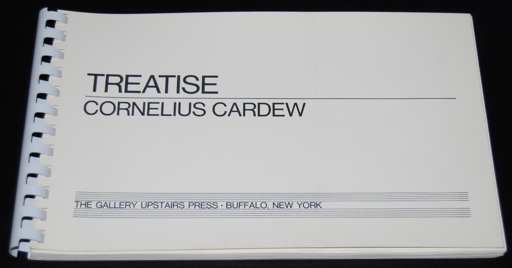  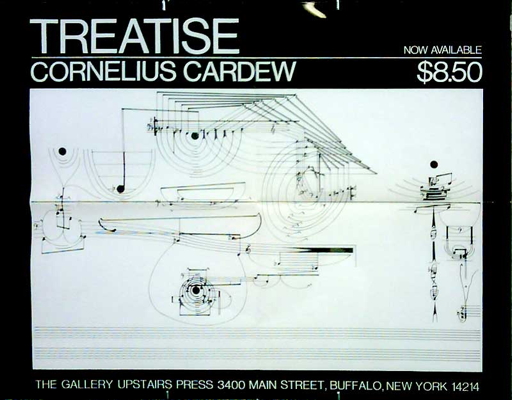 | Treatise score, for any instrument Published by The Gallery Upstairs Press, Buffalo, New York, 1967. 193 pages. 17 x 29 cm. First edition, first printing. Plastic comb binding, card covers, blind stamp from Gallery Upstairs Press on title page. — Source : . Current Publisher : Ed. Peters - Reference : EP7560 — [pdf score download] — [pdf treatise - handbook download] |
 Concerts programmes in London from June 2 to June 16, 1967. — Friday 2nd June 1967 — BBC Third Programme, 3.pm, Cornelius Cardew, one hour performance of Treatise — Source : International Times archive. |
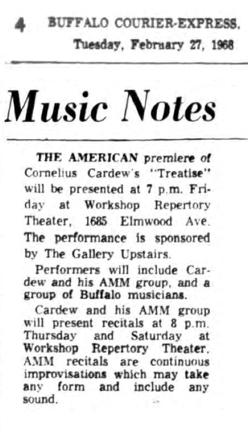 | 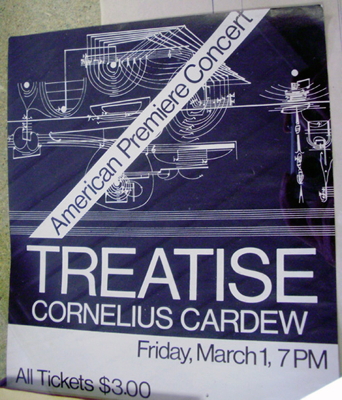 | Treatise, American premiere concert, Friday March 1, 1968, Buffalo (N.Y USA). — Source : Buffalo New York Courier Express. The American premiere of Cornelius Cardew’s « Treatise » will be presented at 7 p.m. Friday at Workshop Repertory Theater, 1685 Elmwood Ave. The performance is sponsored by the Gallery Upstairs. Performers will include Cardew and his AMM group, and a group of Buffalo musicians. Cardew and his AMM group will present recitals at 8 p.m. Thursday and Saturday at Workshop Repertory Theater. AMM recitals are continuous improvisations which may take any form and include any sound. [Buffalo New York Courier Express, Tuesday February 27, 1968, p. 4] |
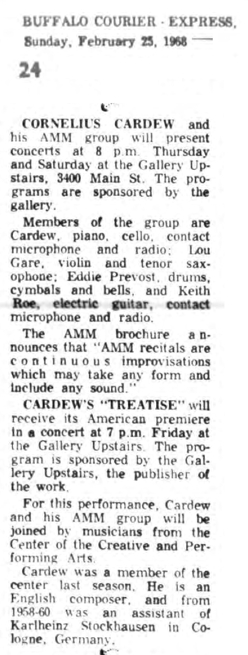 | Treatise, American premiere concert, Friday March 1, 1968, and AMM recitals, Buffalo (N.Y USA). — Source : Buffalo New York Courier Express Cornelius Cardew and his AMM group will present concerts at 8 p.m. Thursday and Saturday at the Gallery Upstairs, 3400 Main St. The programs are sponsored by the gallery. Members of the group are Cardew, piano, cello, contact microphone and radio ; Lou Gare, violin and tenor saxophone ; Eddie Prevost, drums, cymbals and bells ; and Keith Rowe, electric guitar, contact microphone and radio. The AMM brochure announces that « AMM recitals are continuous improvisations which may take any form and include any sound. » Cardew’s « Treatise » wille receive its American premiere in a concert at 7 p.m. Friday at the Gallery Upstairs. The program is sponsored by the Gallery Upstairs, the publisher of the work. For this performance, Cardew and his AMM group will be joined by musicians from the Center of the Creative and Performing Arts. Cardew was a member of the center last season. He is an English composer, and from 1958-60 was an assistant of Karlheinz Stockhausen in Cologne, Germany. [Buffalo New York Courier Express, Sunday February 25, 1968, p. 24] |  | Treatise, American premiere concert, Friday March 1, 1968, Buffalo (N.Y USA). — Source : Buffalo New York Courier Express. « Treatise » — The American premiere of Cornelius Cardew’s « Treatise » will be presented at 7 this evening at the Workshop Repertory Theater, 1685 Elmwood Ave. The avant-garde work will last about five hours, and will be performed by Cardew’s AMM group from England and a group of Buffalo musicians. [Buffalo New York Courier Express, Tuesday March 1, 1968, p. 30] |
Treatise, Wittgenstein and Cardew(Edit)
|
VIDEO Cornelius Cardew, Treatise [excerpt] The QUaX Ensemble, directed by Petr Kotik. Live recording from Prague, 1967. This performance of Treatise was recorded live in Prague in 1967 by the Czech QUaX Ensemble, directed by composer/flutist/conductor Petr Kotik. This historical recording offers a unique perspective to hear Treatise as interpreted by Cardew's contemporaries. Kotik met Cardew in Warsaw in 1962, and they began exchanging scores by mail, including Treatise, which was a work in progress. Upon meeting again in London (1966), Cardew provided Kotik with additional portions of the score and insights. Fresh from this encounter, Kotik started the QUaX Ensemble upon his return to Prague in 1966. The first thing QUaX did was to rehearse Treatise, working through the pages Kotik had: "The piece was very important for getting all of us together, musically speaking, besides having a lot of fun working out individual pages by having all the musicians contribute ideas and suggestions. We worked regularly over a long period of time, ending up with a 2-hour version of the piece ... only performed once, at the concert on October 15, 1967 in Prague." VIDEO Cornelius Cardew, Treatise [excerpt] Formanex + AMM + guests John Tilbury - Eddy Prevost - Keith Rowe - John White - Laurent Dailleau - Anthony Taillard - Christophe Havard - Emmanuel Leduc - Julien Ottavi au festival "Musique Action" à Nancy en juin 2002 à l'occasion du 20ème anniversaire de la mort de Cornelius Cardew, Formanex, AMM et les invités on interprété le "Treatise". |
Wittgenstein’s seminal text inspired Cornelius Cardew’s monumental graphic score, Treatise (1963-67) ; Just what did this music-notational epic have to do with the Tractatus? In fact, Wittgenstein invoked musical notation in an important passage of the Tractatus: “At first glance the proposition – say as it stands printed on paper – does not seem to be a picture of the reality of which it treats. But nor does the musical score appear at first sight to be a picture of a musical piece; nor does our phonetic spelling (letters) seem to be a picture of our spoken language. And yet these symbolisms prove to be pictures – even in the ordinary sense of what they represent. [...] The gramophone record, the musical thought, the score, the waves of sound, all stand to one another in that pictorial internal relation which holds between language and the world. To all of them the logical structure is common. (Like the two youths, their two horses and their lilies in the story. They are all in a certain sense one.) [...] In the fact that there is a general rule by which the musician is able to read the symphony out of the score, and there is a rule by which one could reconstruct the symphony from the line on a gramophone record and from this again – by means of the first rule – construct the score, herein lies the internal similarity between these things which at first sight seem to be entirely different.” — (Wittgenstein, Ludwig: Tractatus Logico-Philosophicus, trans. C. K. Ogden, New York 2003 [1922], p. 39-41 But it would appear that Cardew’s score stands in no clear relation to any sonic content. And yet it was precisely as a self-contained symbolic system that was to be in need of no supplementary clarification that Cardew’s notation was indebted to Wittgenstein’s conception of the logical proposition. According to the Tractatus, an adequately notated logical proposition would be internally consistent, self-evident, and, admitting no supplementary “metalanguage”, fundamentally self-contained. But it would not therefore be divorced from the “world”. It would “describe the scaffolding of the world but ‘treat’ of nothing”. In a gloss on this passage, Cardew wrote of his score-in-process: “Reference. ‘What is the reference of the network?’ This is meaningless. Something – things – should be referable to the network”. — (Cardew, Cornelius: Treatise Handbook, including Bun no. 2 – Volo Solo, New York 1971, p. IV.) Indeed Cardew took Wittgenstein’s hard-to-imagine concept of logical notation as an ideal. Thus, Treatise was to be a self-contained symbolic system without need of any additional directions. That it does not describe or prescribe any particular sounds – no pitches, no rhythms – is the point, since, according to the Tractatus, logical propositions reflect (and are reflected within) the world not as specific empirical things but as formal (or logical) possibilities. For all the apparent attention to graphic elegance, Cardew sharply distinguished between his notational project and what he described as Bussotti’s non-functional “‘aesthetic notations’...[n]otation for its own sake.’” “A musical notation that looks beautiful is not a beautiful notation, because it is not the function of a musical notation to look beautiful (functionalism). Any attempts in this direction (Bussotti) could be called ‘aesthetic notations’. Notation for its own sake, but in a different sense from say, pure mathematics.” — (Cardew, Cornelius: “Nota- tion, Interpretation, Etc.”, in: Tempo 58, Summer 1961, p. 29.) Even though the notation in Treatise designates no specific sound or action, the score was not intended as only a vague stimulus for performance. Cardew writes: “The score must govern the music. It must have authority, and not merely be an arbitrary jumping-off point for improvisation, with no internal consistency.” — (Cardew 1971, p. IV.) A player might decide, for example, that circular shapes always correspond to harmonics, and would then have to determine some sort of rule that makes sonic sense of the variation in circle size, the position of the circles on the page, and so on. Writing about this kind of interpretive decision, Cardew, in his private notes on Treatise, paraphrases Wittgenstein on the role of arbitrary yet binding rules in games: “And if e.g. you play a game you hold by its rules. And it is an interesting fact that people set up rules for pleasure and then hold by them.” — (Ibid., VII.) After five years of struggling with Treatise Cardew eventually recognized insurmountable contradictions in his project. But instead of thinking of the score as a failure he began to understand it as a transitional endeavor that led him to a new conception of music. On a 1970 radio broadcast Cardew described a 1966 performance of Treatise that he participated in with the improvisation collective AMM as the “turning point”, and said: “I now regard Treatise as a transition between my early preoccupations with problems of music notation and my present concerns – improvisation and a musical life. However I would have been a great deal loster if it hadn’t been for the performance of January 1966 [...] Joining AMM was the turning point, both in the composition of Treatise and in everything I have thought about music up to now. Before that, Treatise had been an elaborate attempt at graphic notation of music; after that time it became simply graphic music (which I can only define as a graphic score that produces in the reader, without any sound, something analogous to the experience of music), a network of nameless lines and spaces pursuing their own geometry untethered to themes and modulations, 12-note series and their transformations, the rules or laws of musical composition and all the other figments of the musi- cological imagination. / Up to the time of this performance, improvisation had always terrified me; I thought it must be something like composing, but accelerated a million times, a feat of which I knew I was incapable. With the AMM improvisers I discovered that anyone can play, me too, provided, as a Chinese musician of the 16th century put it, ‘the thoughts are serious, the mind peaceful and the will resolute’, and what comes out in such play is vital and direct, rather than a translation or interpretation of intellect, attitude, notation, inspiration or what have you.” — (Cardew 1971, p X-XI.) Perhaps the trajectory of Cardew’s thought, from his early concern with self-consistent notational systems to his later dedication to improvisational performance and a “musical life”, recalls Wittgenstein’s own philosophical evolution: Having renounced the metaphysical conception of an autonomous and pure logical language, the philosopher conceived of “language-games” whose rules were indissociable from “use”, and thus comprised a “form of life”. There was, in fact, a final turn in Cardew’s philosophical and political development, and once again notation was a source of contention. In 1971, Cardew writes, he found himself “tipped...into the maelstrom of class struggle”. No longer was a “musical life” achieved through experimental modes of improvisation a sufficient goal. To ad- dress real problems in the real world music had to be political, useful, and populist. At the same time, he turned against Treatise and decided that it was in fact no better than Bussotti’s aestheticized scores. Treatise, he concluded, was “a particularly striking outbreak of...a disease of notation, namely the tendency for musical notations to become aesthetic objects in their own right.” — (David Gutkin, "Notation Games: On Autonomy and Play in Avant-Garde Musical Scores", presentation, Wesleyan University) |
- Cornelius Cardew, Treatise - score (1971)
- Cornelius Cardew, Treatise - handbook (1971)
- Cornelius Cardew, Towards an Ethic of Improvisation (1971)
- A Young Persons Guide to Treatise (2009) (Seattle Improvisation Meeting) — Treatise Recordings (Seattle Improvisation Meeting) —Seattle Improvisation Meeting - Treatise page
- Cornelius Cardew, by John Tilbury — (Originally published in Contact no. 26 (Spring 1983), pp. 4-12)
- Virginia Anderson, 'Aspects of British Experimental Music as a Separate Art-Music Culture' — (PhD thesis, Royal Holloway, University of London, 2004)
- David Gutkin, 'Notation Games: On Autonomy and Play in Avant-Garde Musical Scores' — (presentation, Wesleyan University)
